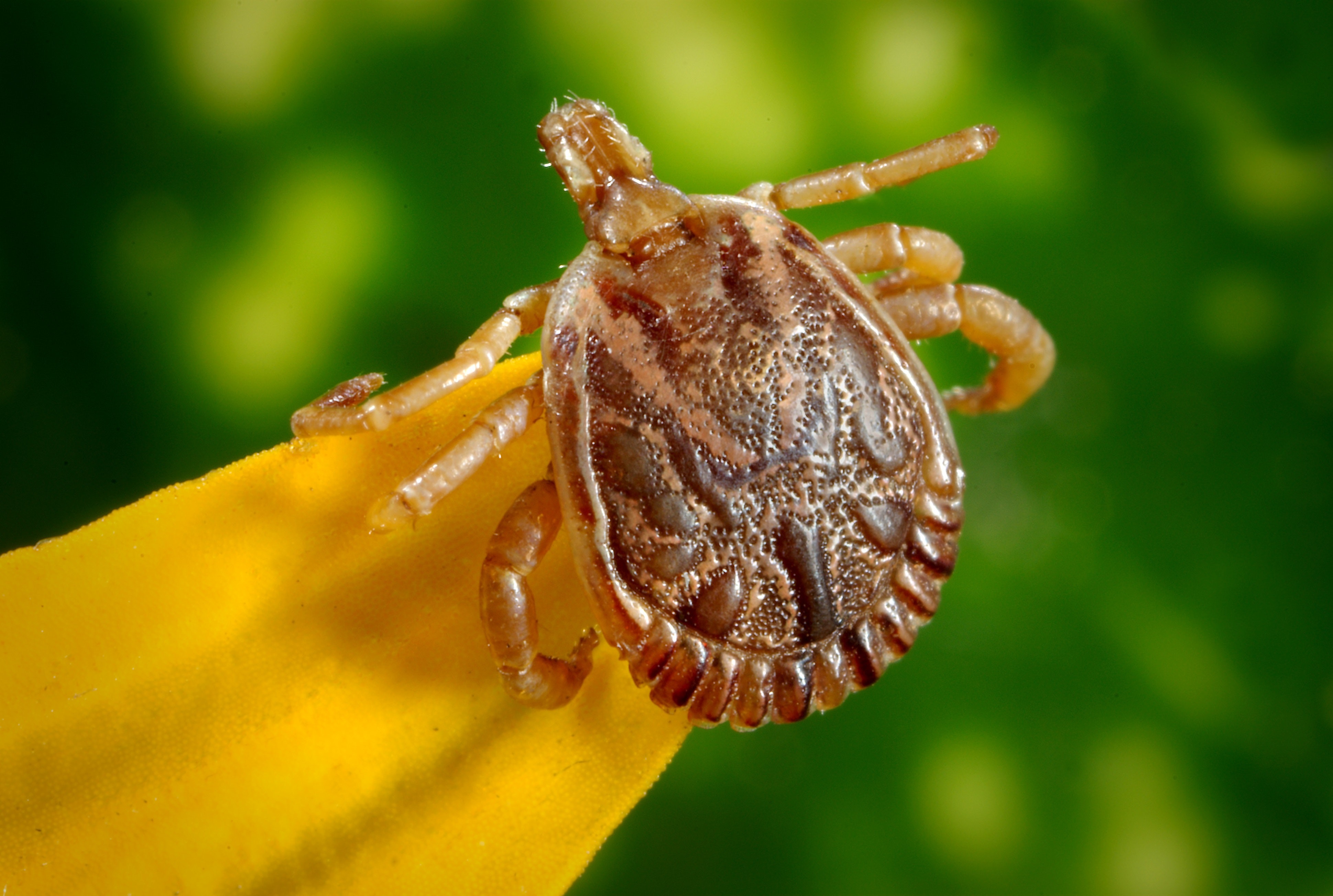September 22nd marks the official start of fall, and though the weather here in North Texas is only beginning to cool off, it’s enough to make adventuring in the great outdoors seem like a relaxing idea for a weekend. Whether you prefer hiking, biking, or taking a stroll with your dog, spending the day in nature can be a great way to unwind and relieve the weekday stress. That is, it can be gloriously peaceful, until you get home and discover that a tiny hitchhiker has found its way home with you. If you’re lucky, you will find this minuscule invader before it has a chance to infest your home and yard, or worse, infect you and your pets with potentially life-threatening diseases. If you’re not so lucky, a simple attempt to have a peaceful weekend could turn into some of the worst months of your life. So what is this tiny terror that’s waiting to wreak havoc on you? None other than the notorious tick.

What do Ticks Look Like?
Ticks come in 2 main families: “hard ticks” and “soft ticks.” Though either type of tick could potentially infest your yard, the four most common types of tick you are likely to encounter are all “hard ticks.” These four varieties are the brown dog tick, the blacklegged or deer tick, the American dog tick, and the lone star tick. Though there are unique characteristics to all 4 types, they do share a few important things in common. They all have a flattened oval body shape and are quite small in size (with unfed adults ranging from 3mm to 5mm in length). After a blood meal, adult females grow significantly and can be up to 15mm in length, or about the size of a large raisin. Since ticks are arachnids, they have 8 legs as nymphs and adults. However, in their larval stage (the stage immediately after they hatch from eggs, but before the nymph stage) they have only 6 legs and are particularly small, about 0.5mm in length (at this stage they are referred to as seed ticks). Tick eggs are spherical and dark brown; they are laid by a single female in clusters of 1,000 to 7,000, depending on species.
Brown dog ticks are approximately 3.18mm long as adults and are a reddish-brown color with no other markings on their bodies.
Blacklegged or Deer ticks are dark brown to black in color with black legs and are about 3mm long as adults. They are sexually dimorphic, meaning males and females look different, with females having a red/orange color behind the scutum (the back “shield” of the tick). The reason this tick has 2 names is it was initially believed to be 2 separate species; however, it is now recognized as a single species and is officially referred to as the blacklegged tick, though some people may still be more familiar with the name deer tick.
American dog ticks are reddish-brown in color as adults with gray/silver markings on their scutum (back “shield”) and are between 3.6mm long (males) and 5mm long (females).
Lone star ticks are a brown or tan color with silvery-white markings; adult females have a single spot on their backs, while males have scattered spots or streaks along the edges of their bodies. They are around 4mm long.

Where do Ticks Live?
Ticks can be found throughout the world and in a wide range of climates. They will almost always be found either outdoors in their preferred habitat or attached to their current host (where they are feeding). The only exception is the brown dog tick, which can complete its entire life cycle either indoors or outdoors. Indoors, you can find this tick in cracks and crevices around baseboards, door frames, and window frames. Outdoors, ticks of all kinds can be found in areas of heavy vegetation, tall grasses, wooded areas, fields, around shrubs, in underbrush, along creeks, in landscaped areas, under decks (if animals have access to this area), in yard clutter and debris, and in other areas where animals frequently visit (dog houses, kennels, etc.). On dog hosts, you can generally find them on the head, ears, back, between the toes, and in the area under the joint where the legs connect to the body. On human hosts, they will generally be in moist, warm areas of the body, like armpits, groin, and under hair.
Though ticks thrive in warm, humid environments, they are extremely resilient and larvae have been shown to be able to survive for months in temperatures around 90°F, in sub-zero winter temperatures while covered in snow, and even submerged in water. In addition, the gradually warming climate has benefited ticks, allowing them to develop faster, feed for a greater part of the year, and even expand their territory. That being said, they are most active from spring through fall, though the blacklegged tick will remain active throughout the winter as long as the ground and air temperatures are above freezing.

What do Ticks Eat?
All 4 types of ticks that are common to North Texas are three-host ticks, which means that between each life stage they will feed on a different host animal for a blood meal (the only exception is the brown dog tick, as they could potentially feed on the same dog in different life stages if they are living in your home with your dog). A tick life cycle begins as an egg, where they will develop for anywhere from a couple days to months before hatching into a larvae. The larvae will then search out a blood meal from an animal by questing. Unlike fleas, ticks cannot jump onto their host; instead, they quest, which is the term to describe their behavior of climbing onto vegetation (i.e. a grass blade), holding onto it with their 3rd pair of legs, and waving their other legs in the air. When a host brushes past the vegetation, the tick simply grabs onto the host and climbs on board. And how do they know where to find hosts? They can detect heat, moisture, breath, body odor, and vibrations, and use that information to find a suitable place to quest.
Generally, the first host for a larval tick will be a small animal, like a mouse. The larvae will feed for a few days to a few weeks, then, once engorged with blood, they will drop off the host and find a secluded place to develop over the next few weeks to months. They then emerge as nymphs and quest for a larger blood meal (often a raccoon or opossum), feed for a few days to a few weeks, drop off the host and develop in a secluded location. Finally, they will emerge as adults, feed on an even larger blood meal (dogs, deer, horses, etc.) for a few days to a few weeks, mate while attached to the host, then drop off, and the female will find a secluded location to lay her eggs before she dies. The entire life cycle can take anywhere from 2 months to 3 years, depending on the weather and the availability of hosts. In each stage of their life cycle, a tick can live a long time without a blood meal (anywhere from 5 months to 2 years). And even worse, there can be multiple generations of ticks each year.
Unfortunately, ticks at all 3 stages of their life cycle can, and do, feed on humans, and the smaller the tick, the less likely you are to discover it. Fortunately, humans aren’t the preferred host for any of these ticks. Brown dog ticks prefer dogs as their hosts, blacklegged ticks and lone star ticks prefer white-tailed deer, and American dog ticks prefer dogs (but will readily attack other large mammals, including humans).

Are Ticks Dangerous?
When a tick uses you or your pet as a host, you have a lot more to worry about than simply the “ew” factor of a bug being firmly attached to you. Ticks are the primary spreader of vector borne disease in the U.S., which means that a bite from one of these pests could easily send you or your pet to the hospital. Even worse, tick-borne disease is on the rise, with the CDC reporting a 19% increase in just a decade. Each type of tick can be a vector for several different diseases, for details on these diseases, see the Texas Health & Human Services article on Tick-borne Diseases as well as the CDC articles on Tickborne Diseases of the United States and Southern Tick-Associated Rash Illness. Below is a brief list of the potential diseases the four common Texas ticks can transmit to humans or pets.
Brown dog tick: Rocky Mountain Spotted Fever (RMSF), Ehrlichiosis, Babesiosis
Blacklegged tick: Lyme disease, Babesiosis, Ehrlichiosis, Anaplasmosis, relapsing fever, Powassan virus disease
American dog tick: Rocky Mountain Spotted Fever, Tularemia, Canine Tick Paralysis
Lone star tick: Alpha-gal syndrome (red meat allergy), Ehrlichiosis, Tularemia, Heartland virus disease, Southern Tick-Associated Rash Illness (STARI), Bourbon virus disease
To illustrate the severity of just a few of these diseases: Rocky Mountain Spotted Fever has about a 25% human mortality rate if untreated and a 5% mortality rate if treated; Canine Tick Paralysis occurs when a tick attaches to the back of the neck or base of the skull (most commonly of a dog or child) and releases a salivary gland protein that slowly paralyses the host, and if not removed after several days of feeding, can cause respiratory failure and death (fatality rate is about 10% for humans, most of whom are children); Alpha-gal syndrome has no known cure; Lyme disease can spread to joints, the heart, and the nervous system with long-term consequences. While the risks to adult humans can be severe, the risks to children, pets, and those with compromised immune systems can prove fatal.

How do you Prevent Ticks?
Preventing ticks can be broken down into 3 main categories: personal, exterior, and interior. In order to keep you and your family safe, it’s important to practice all 3 types of prevention.
Personal
- Regularly groom and inspect pets that go outdoors for possible ticks
- Inspect people and pets immediately after being in potential tick infection zones (outdoor tick habitats, kennels, dog groomers, dog parks, and other areas highly frequented by dogs or wildlife)
- Maintain appropriate tick treatments for pets as recommended by your vet
- Wear appropriate clothing when in potential tick habitats (long-sleeve shirts, pants tucked into socks at the cuffs, light colored clothing, etc.)
- If walking in potential tick habitats frequently check your clothes for ticks
- Utilize tick repellents
Exterior
- Maintain a pest control service with The Bug Dude to keep rodents (a common tick host) away from your home
- Call The Bug Dude @ 800-310-BUGS (2847) if you suspect an issue with wildlife in or around your home as they are often carriers of ticks
- Remove potential rodent & wildlife harborage and feeding areas around your home (check out our articles on rodent & wildlife control, such as rats, rodents, squirrels, and raccoons)
- Seal any cracks and crevices around the perimeter of your home, especially near landscaping, shrubs and grassy areas
- Keep grass and weeds cut short
- Remove brush piles & leaf litter
- Keep shrubs trimmed
- Keep stacked wood away from your home and areas frequented by people or pets
- If your home backs up to a tall grass or wooded area, place a 3 feet wide strip of wood chips or gravel between that area and your yard to act as a barrier
- Keep decks, patios, playground equipment, benches, etc. away from yard edges and trees
- Utilize fences to discourage unwanted animals from entering your yard (i.e. deer and stray dogs)
- Keep your yard tidy and free of debris
- Remove bird feeders or place them only at the edge of your yard
- Keep gutters clean
Interior
- Regularly wash dog beds/blankets in hot water and dry in high heat to kill any potential ticks
- Seal cracks & crevices around baseboards, windows, and doors
How do you Eliminate Ticks?
Tick infestations are notoriously difficult and time-consuming to treat, with bigger infestations being exponentially more complicated to eliminate. Combine that with the potential risks to you and your family if a tick decides to feed on any of you, and you can see that it’s vital to get any infestation promptly treated. If you suspect you have a tick infestation on your hands, whether in your yard or in your home, call The Bug Dude at 817-354-5350 immediately to have our expert technicians inspect, evaluate, and treat the danger zones before the problem escalates.
So this fall, as you venture out for a relaxing wilderness walk, or spend a long day at the dog park, remember to keep a watchful eye out for ticks to keep your peaceful weekend from becoming a prolonged nightmare.
Further Reading:
“common name: brown dog tick / scientific name: Rhipicephalus sanguineus Latreille (Arachnida: Acari: Ixodidae)” – Yuexun Tian, Cynthia C. Lord, and Phillip E. Kaufman, University of Florida
“common name: blacklegged tick or deer tick / scientific name: Ixodes scapularis Say (Arachnida: Acari: Ixodidae)” – Michael R. Patnaude, University of Florida, and Thomas N. Mather, University of Rhode Island
“common name: American dog tick / scientific name: Dermacentor variabilis (Say) (Arachnida: Ixodida: Ixodidae)” – Wai-Han Chan and Phillip E. Kaufman, University of Florida
“Lone Star Tick” – Field Guide to Common Texas Insects – Texas A&M AgriLife Extension
“A Closer Look at Ticks That Spread Disease” – Brittany Campbell, Ph.D., BCE – Control Solutions Inc.
“Ticks on the Move” – Chelle Hartzer – PCT
Author Bio: Alissa Breach has been gaining knowledge and experience around pest control concerns over the last 12 years while working for Mid-Cities Pest Control. She has a creative writing BA from UW-Madison and is always pursuing new and interesting writing projects.




